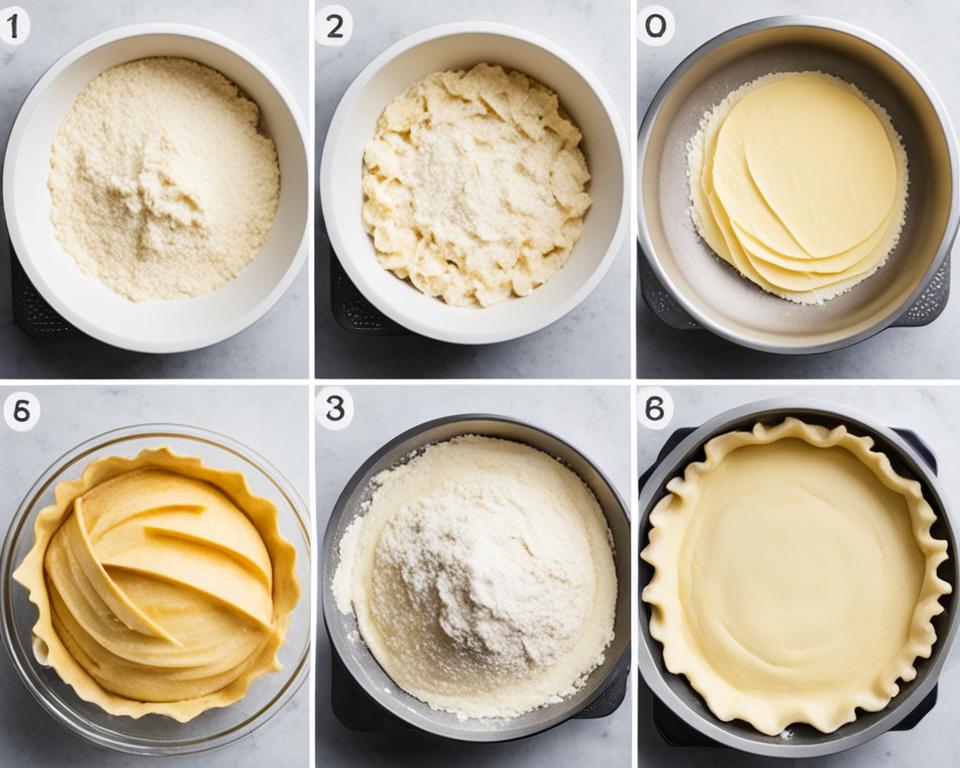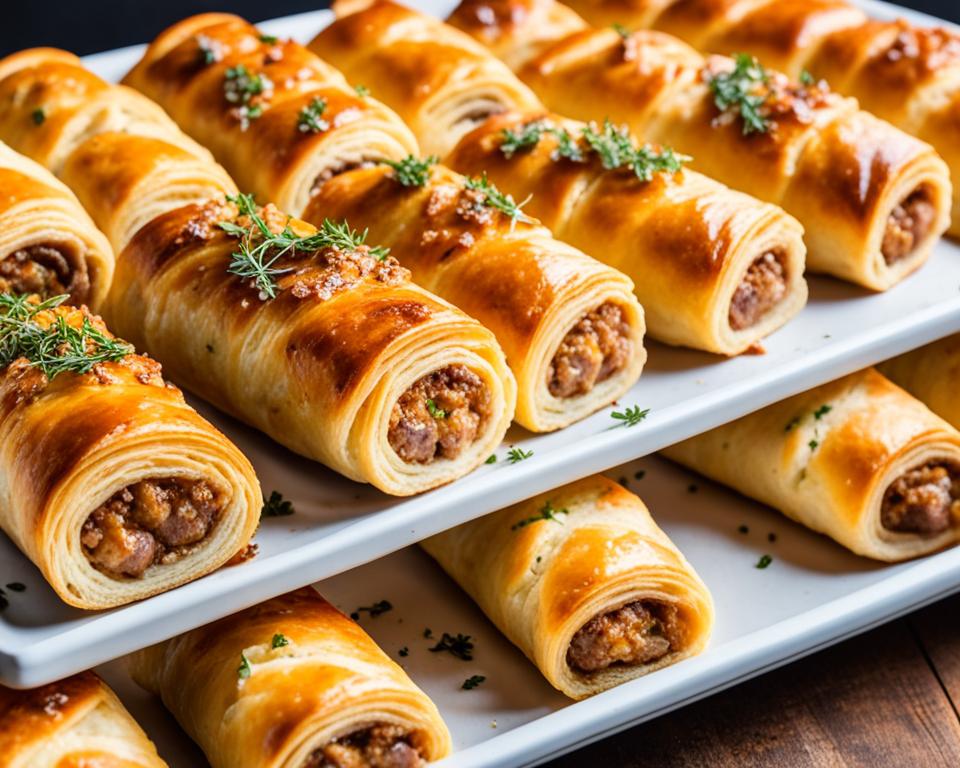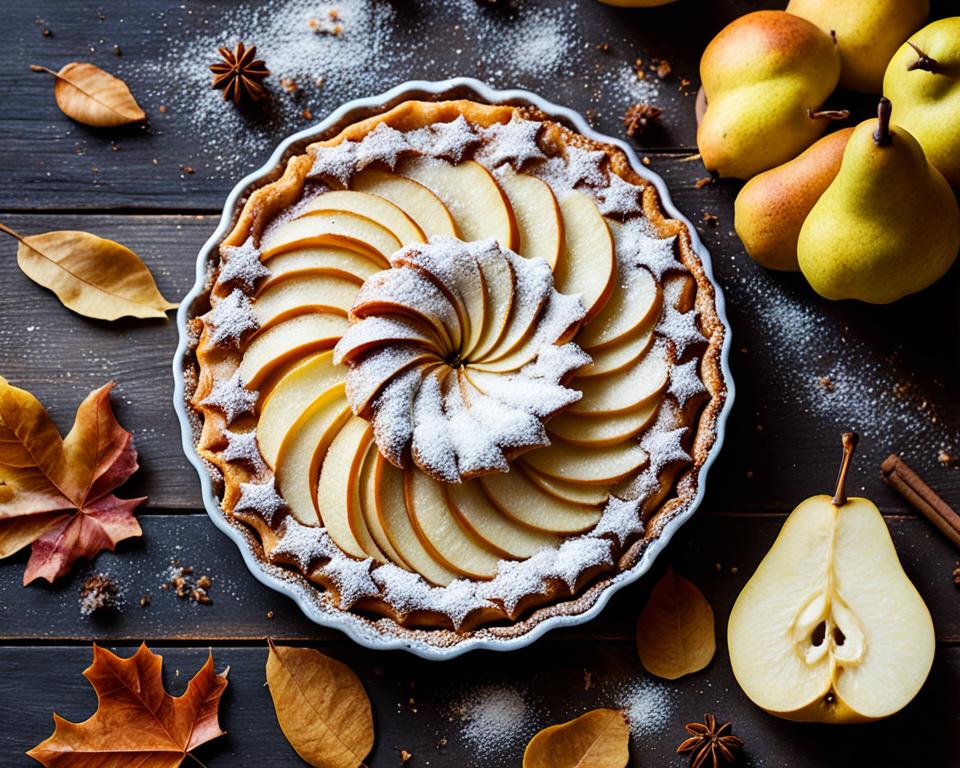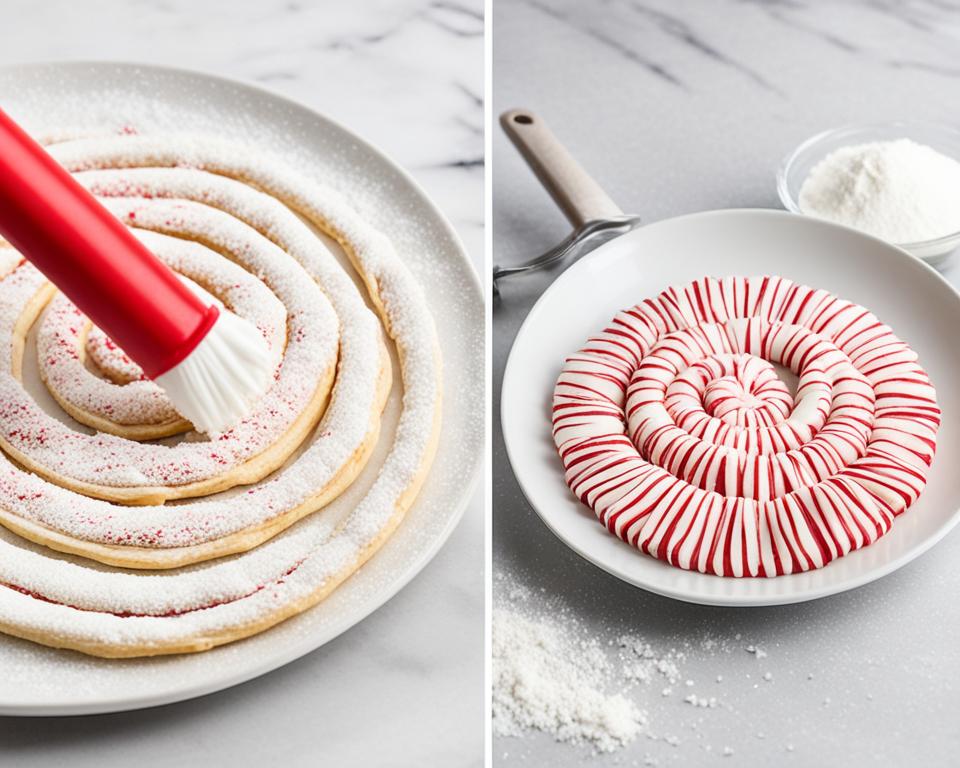Welcome to our guide on creating the perfect flaky crust for your pies and tarts. Whether you’re a seasoned baker or a novice in the kitchen, this homemade flaky crust recipe will elevate your baked goods to a whole new level. Get ready to impress your friends and family with a buttery and tender crust that will have them coming back for seconds!
Creating a flaky crust doesn’t have to be complicated. With a few key tips and the right ingredients, you’ll be well on your way to mastering this essential pastry skill. We’ll walk you through each step, from choosing the best ingredients to mixing and shaping the dough, and even provide some creative uses for your versatile pie dough. Let’s dive in and discover the secrets to making the best flaky crust!
Key Takeaways:
- Creating a homemade flaky crust is worth the effort for its superior flavor and texture.
- High-quality ingredients such as King Arthur Unbleached All-Purpose Flour and cold butter are vital for achieving the perfect crust.
- Keep your pie dough and ingredients as cold as possible to create flaky layers.
- Mix the butter and flour until the mixture resembles coarse crumbs, then gradually add ice water to bring the dough together.
- Pie dough can be used for more than just traditional pies – think mini pecan pies, fruit galettes, and hand pies!
Why Homemade Pie Crusts Are Worth the Effort
Making your own pie crust from scratch may seem like a daunting task, but the results are truly worth it. When it comes to flavor and texture, store-bought crusts simply can’t compete with a homemade flaky crust. By taking the time to make your own crust, you have full control over the ingredients, resulting in a pie that is truly exceptional in taste and quality.
The benefits of homemade pie crust are numerous. Firstly, you can choose the highest quality ingredients, ensuring that your pie is made with the freshest and most flavorful components. Whether it’s using premium butter or selecting the perfect flour, you have the ability to create a crust that is tailored to your preferences and dietary needs.
“Store-bought pie crust simply can’t match the flavor and texture of a homemade flaky crust.”
Additionally, making your own pie crust allows you to experiment and customize the recipe to your liking. You can add unique flavors such as spices or citrus zest, or even incorporate different types of flours for a unique twist. The possibilities are endless, and you can truly make your pie crust a reflection of your personal taste.
Not only does homemade pie crust elevate the taste of your pies, but it also adds a special touch of love and care to your baked goods. The process of making the crust from scratch requires time and effort, but the satisfaction of serving a pie with a homemade crust is unmatched. It’s a true labor of love that will leave your family and friends in awe of your baking skills.
So why make pie crust from scratch? The answer is simple – the benefits are undeniable. From the superior flavor to the sense of accomplishment, homemade pie crust takes your pies to a whole new level. Give it a try and experience the joy of creating a truly exceptional pie from start to finish.
The Importance of Good Ingredients
To achieve the perfect flaky crust, it is important to use high-quality ingredients. Start with a good all-purpose flour, such as King Arthur Unbleached All-Purpose Flour, which has a higher protein content for better rise and freshness. Both butter and shortening play a crucial role in creating a flaky texture, with butter adding flavor and flakiness and shortening providing structure and stability. Ice water is added to bring the dough together, with some recipes recommending the use of vodka for extra flakiness.
The Importance of Temperature
When it comes to achieving a flaky crust for your pies and tarts, the temperature of your ingredients plays a vital role. Keeping your pie dough and ingredients as cold as possible is essential for creating those delightful layers that make your crust light and airy.
In order to understand why cold ingredients are important, let’s take a closer look at the science behind it. When cold butter and shortening are mixed with the flour, they form small, pea-sized pieces. During baking, these pieces melt and create pockets of steam. The steam then pushes against the layers of dough, resulting in a flaky texture.
To ensure that your crust turns out perfectly flaky, here are a few key steps to follow:
- Chill the butter and shortening before incorporating them into the dough. This helps to maintain their solid state and prevents them from melting too quickly during the mixing process.
- Refrigerate the dough for a minimum of 2 hours before rolling it out. This allows the fat to solidify and the gluten in the flour to relax, making it easier to work with and preventing shrinkage during baking.
By following these temperature guidelines, you’ll be on your way to creating a beautiful and flaky crust that will leave your friends and family impressed.
Benefits of Using Cold Ingredients:
- Promotes the formation of steam pockets, resulting in flaky layers.
- Prevents the fat from melting too quickly, allowing it to create a tender and delicate texture.
- Helps the dough hold its shape and prevents excessive spreading during baking.
| Ingredient | Temperature |
|---|---|
| Butter | Cold and firm |
| Shortening | Cold and solid |
| Flour | Room temperature |
By paying attention to the temperature of your ingredients and following proper refrigeration techniques, you can achieve that perfect flaky crust that will take your pies and tarts to the next level.
Mixing and Shaping the Dough
To create the perfect flaky crust, you need to master the art of mixing and shaping the dough. This crucial step sets the foundation for a buttery and tender crust that will impress your friends and family.
Start by combining cold butter and shortening with the flour. Using a pastry cutter or forks, work the fats into the flour until the mixture resembles coarse crumbs. Remember, cold fats are essential for achieving that sought-after flakiness.
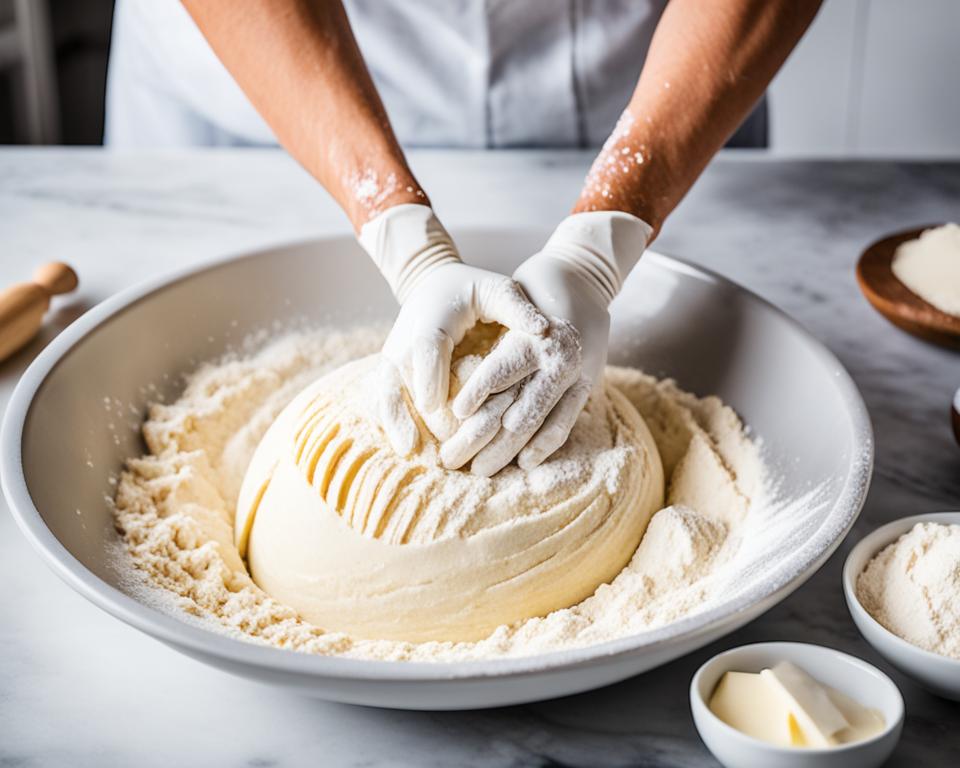
Once you’ve achieved the desired texture, it’s time to add the secret ingredient – ice water. Gradually drizzle in the ice water as you continue to mix the dough. You want the dough to clump together but not become overly sticky. This may require adding more or less water depending on the humidity of your kitchen.
Now that the dough has come together, shape it into a ball and divide it into two portions. This division is perfect for double-crust pies or for saving one portion of dough for future use. Wrap each portion tightly in plastic wrap and refrigerate for at least 30 minutes, allowing the gluten to relax and the fats to firm up.
With the dough mixed and shaped, you’re ready to take your pie and tart creations to the next level. The next section will cover tips for rolling and storing the dough, ensuring that you have everything you need to create a picture-perfect crust.
Tips for Rolling and Storing the Dough
When it comes to creating the perfect pie crust, rolling out your dough correctly is key. By following a few simple tips, you can ensure that your crust turns out beautifully flaky and buttery every time.
Start by placing your chilled dough on a well-floured surface. Use a rolling pin to gently roll the dough from the center outwards, turning it as you go. This technique helps to maintain an even thickness throughout the crust and prevents it from sticking to the surface.
To further prevent sticking, don’t be afraid to incorporate additional flour as needed. Sprinkle a little extra flour on top of the dough and on your rolling pin to keep everything smooth and easy to work with.
Once your dough is rolled out to the desired size and thickness, it can be used immediately for your pie or tart. However, if you’re not ready to bake just yet, you can store the dough for later use.
Refrigerating the dough is an excellent option if you’re planning to use it within a day or two. Simply wrap the dough tightly in plastic wrap or place it in a resealable bag, then refrigerate for at least 30 minutes. This helps to firm up the fats in the dough, making it easier to handle and resulting in a flakier crust.
If you want to prepare your dough well in advance, freezing is a great option. Wrap the dough tightly in plastic wrap and place it in a resealable freezer bag. Make sure to label the bag with the date and contents. Frozen pie dough can be stored for up to 3 months, giving you the flexibility to bake pies whenever you desire.
Tips for Rolling and Storing Pie Dough
- Start rolling from the center and work your way out, turning the dough as you go.
- Use additional flour to prevent sticking and maintain a smooth rolling surface.
- Refrigerate the dough for at least 30 minutes before rolling to firm up the fats.
- Wrap the dough tightly in plastic wrap or place it in a resealable bag for refrigeration.
- To freeze the dough, wrap it tightly in plastic wrap and place it in a resealable freezer bag. Label with the date and contents.
- Frozen pie dough can be stored for up to 3 months.
Using Pie Dough for Various Recipes
Pie dough is a versatile ingredient that goes beyond traditional pie crusts. Its flexibility allows you to explore creative uses and experiment with different recipes in the kitchen. Whether you’re craving mini pecan pies, fruit galettes, hand pies, or even homemade pop tarts, pie dough can be the base for a wide range of delightful treats.
Let’s take a closer look at some of the creative uses for versatile pie dough:
1. Mini Pecan Pies
Did you know that you can use pie dough to create individual-sized pecan pies? These mini treats are perfect for parties or when you’re hosting guests. The flaky crust combined with the sweet and nutty pecan filling creates a delightful bite-sized dessert.
2. Fruit Galettes
Take advantage of the seasonal fruits and make fruit galettes using pie dough. Simply roll out the dough, place your favorite fruits in the center, and fold the edges over to create a rustic, free-form tart. The result is a beautiful and delicious dessert that showcases the natural flavors of the fruits.
3. Hand Pies
Hand pies are portable treats that are perfect for on-the-go snacking or packed lunches. Fill individual rounds of pie dough with your choice of sweet or savory fillings, fold them over, and seal the edges. These little pockets of goodness can be enjoyed with a variety of fillings, from apple and cinnamon to savory options like chicken and vegetables.
4. Homemade Pop Tarts
Indulge in nostalgia and create your own homemade pop tarts using pie dough. These sweet treats can be customized with different fillings and topped with a simple glaze or sprinkles. Perfect for breakfast or a sweet afternoon snack, homemade pop tarts are sure to bring a smile to your face.
As you can see, pie dough is not limited to traditional pie crusts. Its versatility opens up a world of possibilities for creating unique and delicious desserts. So, go ahead and unleash your creativity in the kitchen with pie dough!
Tips for Blind Baking and Double-Crust Pies
Blind baking is an essential technique for certain pie recipes, such as quiches or cream pies. It involves pre-baking the crust before adding the filling, ensuring that the crust is fully cooked and doesn’t become soggy. Here are some tips to help you master blind baking:
- Start with a well-chilled pie crust. This will help maintain the shape and structure of the crust during baking.
- Roll out the pie dough and carefully transfer it to the pie dish. Trim any excess dough and crimp the edges for a decorative finish.
- Line the pie crust with parchment paper or aluminum foil, and fill it with pie weights or dried beans to prevent the crust from puffing up during baking.
- Bake the crust in a preheated oven at the recommended temperature until it is lightly golden brown. Remove the pie weights and continue baking for a few more minutes to ensure the crust is fully cooked.
- Allow the blind-baked crust to cool completely before adding the filling. This will prevent the filling from becoming watery and seeping into the crust.
For double-crust pies, creating a lattice top adds a beautiful and decorative touch to your pie. Here’s how to create a lattice top:
- Roll out the top crust and cut it into strips of equal width.
- Place half of the strips horizontally across the pie filling, leaving some space between each strip.
- Fold back every other strip halfway and place a new strip vertically along the unfolded strips.
- Unfold the folded strips and fold back the remaining strips. Place another strip vertically.
- Continue this process until the lattice is complete.
- Trim the excess dough and crimp the edges to seal the lattice top with the bottom crust.
These tips will help you achieve a perfectly baked pie crust and create a stunning lattice top for your double-crust pies. Enjoy the flaky and delicious results!
Conclusion
In conclusion, making your own flaky crust for pies and tarts is well worth the effort. With the right ingredients, techniques, and tips, you can achieve a buttery and tender crust that elevates your baked goods to the next level. Whether it’s for a special occasion or a simple treat, homemade pie crust adds that extra touch of love and care to your desserts. So go ahead and give it a try – you won’t be disappointed!
FAQ
Why should I make my own pie crust instead of buying store-bought?
Making your own flaky crust allows for full control over ingredients, resulting in superior taste and quality compared to store-bought crusts.
What are the key ingredients needed for a flaky crust?
A good all-purpose flour, butter, and shortening are essential for creating a buttery and flaky texture in the crust.
How important is the temperature of the ingredients?
Keeping the butter, shortening, and dough as cold as possible is crucial for achieving a flaky crust with pockets of steam during baking.
What is the process for mixing and shaping the dough?
The butter and shortening should be mixed with the flour until coarse crumbs are formed. Ice water is added gradually until the dough clumps together without being too sticky. The dough is then shaped into a ball and divided as needed.
How do I roll out the pie dough and can it be refrigerated or frozen?
The dough should be rolled out from the center, turning it as needed for even thickness. Excess flour can be used to prevent sticking. The dough can be used immediately or refrigerated for later use, or even frozen for up to 3 months.
What other recipes can I make using pie dough?
Pie dough is versatile and can be used for a variety of recipes such as mini pecan pies, fruit galettes, hand pies, and even homemade pop tarts.
Are there any additional tips for blind baking and creating double-crust pies?
Blind baking helps ensure fully cooked crusts for recipes like quiches or cream pies. Tips for creating a lattice top for double-crust pies and proper sealing and decorative techniques are also provided.

